
This unit walks students through a variety of activities revolving around George Orwell's book '1984'.
- Subject:
- English Language Arts
- Material Type:
- Unit of Study
- Provider:
- Michigan Virtual
- Author:
- Abby Perdok
- Date Added:
- 06/28/2017

This unit walks students through a variety of activities revolving around George Orwell's book '1984'.

In this unit, students will learn about ticker tape diagrams and vector diagrams. Lessons in this unit include: Introduction; Ticker Tape Diagrams; and Vector Diagrams. This unit includes animations and mini quizzes to check for understanding and facilitate learning.

In this unit, students will learn about the equations that describe the motion of an object. Lessons in this unit include: The Kinematic Equation; Kinematic Equations and Problem-Solving; Kinematic Equations and Free Fall; Sample Problems and Solutions; and Kinematic Equations and Graphs. This unit includes animations and mini quizzes to check for understanding and facilitate learning.

In this unit of study, students will learn how to use position versus time graphs to describe motion. Lessons in this unit include: Meaning of Shape for a p-t graph; Meaning of Slope for a p-t Graph; and Determining slope on a p-t Graph. This unit includes videos, animations, and mini quizzes to check for understanding and facilitate learning.

In this unit of study, students will learn how to describe motion with velocity versus time graphs. Lessons in this unit include: Meaning of Shape for a v-t Graph; Meaning of Slope for a v-t Graph; Relating the Shape to the Motion; Determining Slope on a v-t Graph; and Determining Area on a v-t Graph. This unit includes videos, animations, and mini quizzes to check for understanding and facilitate learning.

In this unit students will learn how to analyze the motion of objects. Students will begin to make a mathematical connection with words that describe motion. This unit will focus on several examples of vector and scalar quantities (distance, displacement, speed, velocity, and acceleration). As students proceed through the lessons, they should give careful attention to the vector and scalar nature of each quantity. This tutorial also includes animations of each of the major concepts. At the end of each lesson students can check for understanding of concepts by answering concept questions.

In this unit, students will learn about free fall and the acceleration of gravity. Lessons in this unit include: Introduction to Free Fall; The Acceleration of Gravity; Representing Free Fall by Graphs; How Fast? and How Far? This unit includes videos, animations, and mini quizzes to check for understanding and facilitate learning.
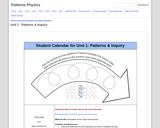
In Part 1 of this unit, students will learn about data collection, graphing skills (both by hand and computer aided [Desmos]), and the fundamental mathematical patterns of the course: horizontal line, proportional, linear, quadratic, and inverse. Students perform several experiments, each targeting a different pattern and build the mathematical models of physical phenomena. During each experiment, students start with an uninformed wild guess, then through inquiry and making sense through group consensus, can make an accurate data informed prediction.

This unit was created by the Rethink Education Content Development Team. This course is aligned to the NC Standards for 1st Grade ELA in Language.
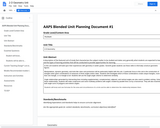
In this unit students will build upon their experiences with geometry in earlier grades. Seventh grade students use these skills to informally construct geometric figures.
Manipulatives, dynamic geometry, and tools like rulers and protractors will be particularly helpful with this unit. A particular focus in this unit is the construction of triangles when given combinations of measures of three angles and/or sides. Students will investigate which of these combinations create unique triangles, more than one triangle, or no triangle at all. Students will use the angle-angle criterion to determine similarity.
Angle relationships generated by intersecting lines including supplementary, complementary, adjacent, and vertical angles are also used in problem solving. Using these relationships, students will make conjectures and solve multistep problems with angles created by parallel lines cut by a transversal. They will also examine both angle sums of polygons and exterior angles.
Students will know and use formulas for the area and circumference of a circle and be able to determine the relationship between them.
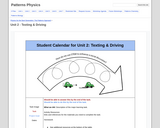
Students are confronted with a scenario of a student who is texting and driving in the school parking lot and they are tasked to determine the effect of various parameters to see if a student will collide with a pedestrian. Students must begin by breaking the scenario down into more manageable parts to determine what must be studied about the situation. Through a series of labs and activities, students learn how to model and predict situations with constant velocity and acceleration. Then, coding a spreadsheet, students model the complex situation of a texting driver, reacting, and braking during a potentially hazardous situation to create an evidence-based argument.
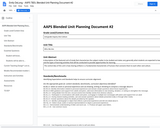
The central idea of this unit is how sharing artifacts is a fundamental characteristic of humans that connects them to each other and culture.
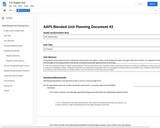
In this unit, students develop in-depth understanding of volume and surface area. Students should understand volume as a measure of filling and surface area as a measure of wrapping an object. Students should have the opportunity to generate their own strategies for finding volume and surface area. Students will be able to use patterns and rules/formulas for finding surface area and volume of three-dimensional shapes.

In order to contextualize the Energy unit, students are tasked to engineer a bungee cord that will optimize the enjoyment of a doll’s bungee jump. To do this, students first develop the mathematical patterns through inquiry on gravitational energy, kinetic energy, and elastic energy. Once the patterns have been established, students further build on their spreadsheet coding skills, in order to use computational thinking to create a program that will help predict the length of bungee cord necessary for a variety of situations.

In this unit, students will be introduced to poetry. Students will learn about the different types of poetry characteristics through the use of poetry books, prezi presentations, music, and spoken word.
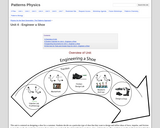
This unit is centered on designing a shoe for a customer. Students decide on a particular type of shoe that they want to design and utilize ideas of force, impulse, and friction to meet the needs of a particular customer. Force plates are used study the relationship between force, time, and impulse to allow students to get the mathematical models that allow them to make data informed decisions about their shoe design.

This resource provides lessons for students to learn the following about babysitting: roles and responsibilities, keeping children safe, handling accidents and emergencies, following a routine, how to feeding young children, and games children play.
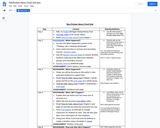
This unit combines nonfiction reading, biographies, Henry Ford, and Michigan history into one unit. It covers many informational reading standards and Michigan social studies standards all together.

Students will be reading historical fiction book at their own level. They will read, summarize, and create three book projects that correlate with some of the 4th grade common core reading standards.
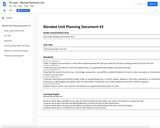
This unit engages students in a variety of different reading standards through face to face and online components. In this unit, students will practice many skills to aid them in reading and understanding nonfiction texts.